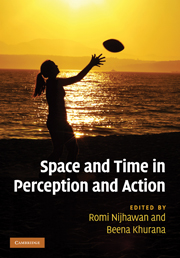Book contents
- Frontmatter
- Contents
- List of contributors
- Acknowledgments
- 1 Space and time: the fabric of thought and reality
- Part I Time–space during action: perisaccadic mislocalization and reaching
- Part II Temporal phenomena: perception
- Part III Temporal phenomena: binding and asynchrony
- Part IV Spatial phenomena: forward shift effects
- Part V Space–time and awareness
- 28 Object updating: a force for perceptual continuity and scene stability in human vision
- 29 A motion illusion reveals the temporally discrete nature of visual awareness
- 30 Priming and retouch in flash-lag and other phenomena of the streaming perceptual input
- Index
- References
28 - Object updating: a force for perceptual continuity and scene stability in human vision
from Part V - Space–time and awareness
Published online by Cambridge University Press: 05 October 2010
- Frontmatter
- Contents
- List of contributors
- Acknowledgments
- 1 Space and time: the fabric of thought and reality
- Part I Time–space during action: perisaccadic mislocalization and reaching
- Part II Temporal phenomena: perception
- Part III Temporal phenomena: binding and asynchrony
- Part IV Spatial phenomena: forward shift effects
- Part V Space–time and awareness
- 28 Object updating: a force for perceptual continuity and scene stability in human vision
- 29 A motion illusion reveals the temporally discrete nature of visual awareness
- 30 Priming and retouch in flash-lag and other phenomena of the streaming perceptual input
- Index
- References
Summary
Summary
How does the visual system provide us with the perception of a continuous and stable world in the face of the spatial–temporal chaos that characterizes its input? In this chapter we summarize several programs of research that all point to a solution we refer to as object updating. We use this phrase because perceptual continuity seems to occur at an object level (as opposed to an image level or a higher conceptual level) and because our research suggests that the visual system makes a sharp distinction between the formation of new object representations versus the updating of existing object representations. We summarize the research that led us to this view in the areas of masking by object substitution, the flash-lag illusion, response priming, and an illusion of perceptual asynchrony.
Introduction
Biological vision is the marvelous ability of an organism to be informed about its surroundings at a distance and with a high degree of spatial and temporal resolution. This ability allows us to know where things are, what shape and color they are, and equally importantly, when they are there, so that we may interact with them appropriately. Yet, contrary to many people's implicit understanding of how biological vision is accomplished, it is not a process by which light, reflected from surfaces in the three-dimensional world, is recorded faithfully by the brain in order to reconstruct the nature of the surfaces that gave rise to the recorded pattern of light.
Information
- Type
- Chapter
- Information
- Space and Time in Perception and Action , pp. 503 - 520Publisher: Cambridge University PressPrint publication year: 2010
References
Accessibility standard: Unknown
Why this information is here
This section outlines the accessibility features of this content - including support for screen readers, full keyboard navigation and high-contrast display options. This may not be relevant for you.Accessibility Information
- 15
- Cited by
